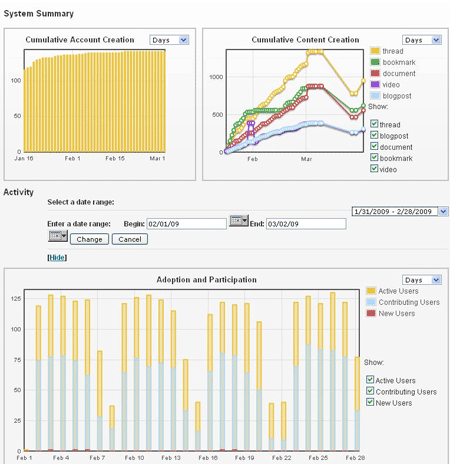All that Jive: Putting the 'social' into business software


Jive Software announced the latest iteration of their Clearspace product today, and it has expanded significantly in size and scope.
From origins as a forums and instant messenger vendor, Jive in 2006 launched 'Clearspace', a single application with wikis, blogs, discussions, instant messaging, RSS, email integration and files into spaces organized by topic. This in turn morphed into internal-focused ('Clearspace') and external-focused ('Clearspace Community') versions.
Jive have now renamed Clearspace 'Social Business Software' (SBS), and are making a play as an enterprise-class, company-wide backbone for all facets of business collaboration.
Jive's proposition is that they are now increasingly competing against Microsoft and IBM, with the 'pure play' smaller vendors no longer able to compete against these larger players. Jive now calls itself the (Little) big company based on their claimed 70% year on year growth, 2,500+ customers and operations in five countries.
SBS 3.0 is essentially a suite of social business applications designed for Global 2000 enterprises based on extensive consultation with clients and analysts such as Forrester. It aims to allow people from inside and outside an enterprise to connect, communicate and collaborate, reducing the cost, time and risk required to produce business results by improving performance.
There are now four application centers: Innovation, Employee Engagement, Marketing & Sales and Customer Support. Jive SBS 3.0 provides a significant new bridge application that aims to link internal employee collaboration with external partner and customer communities within a single application suite.
This illustration shows the 'foundation' of SBS, which is essentially Clearspace 3.0.

New modules include new 'Analytics' activity tracking (image at the top of this post), the centralized view across employee, customer, and partner marketplaces provided by the 'Bridging' application, 'Insight' for innovation and understanding engagement and sentiment, and integrated 'Video'. The four application 'centers' sit on top of this logic.
From my conversation with Jive CMO Sam Lawrence today, it appears the upgrade path for existing Clearspace users will provide the foundation layer: the modules are an additional cost beyond this.
With this announcement and product roll out, Jive are moving the enterprise 2.0 space into a new level of maturity: This is software that competes with Oracle Social CRM and is clearly designed to compete with upcoming offerings from IBM/Lotus and whatever front end Microsoft creates and/or sanctions for their Sharepoint .net environment.
(SBS 3.0 like Clearspace 2.5 can use Sharepoint as a document repository back end, while a huge benefit of Jive and other collaboration software is to wean people off the incredible inefficiency of email such as Lotus Notes).
I haven't had access to the actual software yet; this post is based on my briefing today and associated slides, screenshots and PR materials. Jive have always done an excellent job of presenting complex software in attractive, easy to digest marketing packages and user interface design. They are now getting into a world where they are proposing to be a mission critical enterprise backbone.
Where Clearspace might be picked up by teams within a company for discretionary use, SBS 3.0 proposes to be at the epicenter of all business collaboration. Whether Jive as a 'little' big company has the ability to build out software at this level - they had a RIF of 36 jobs after their VC backers Sequoia's famous gloom and doom slide deck last fall, including much of the executive team - remains to be seen in a rapidly changing business climate.
Although Jive had a terrific fourth quarter last year and by all accounts the one we are in now is equally strong, SBS 3.0 puts them into an area where sales teams sell solutions that can sit on the shelf through lack of uptake internally.
Dennis Howlett and I discussed today's briefing this afternoon and the 90-9-1 rule came up: 1% are creators, 9% editors and the other 90% are a passive audience of lurkers.
Jive have their Clearstep community for users, extensive training materials and a new consulting wing to help customers get traction, but the reality for all 'social community' roll outs is that the software is a relatively minor component compared to the change management required to drive uptake and usage and to weave the software into the business fabric of day to day use.
Careful strategic planning and being careful what you wish for are still much more important than the latest shiny objects, particularly now that JIve propose you entrust all you relationships and communication to their enterprise-class environment.
Clearspace had various teething problems before really hitting its stride with version 2.5; this ambitious new business architecture is likely to encounter similar issues. These are early days yet, but it is fascinating to see Jive move the needle with this latest release announcement.
There's much to like and admire in this package, but I suspect creating a whole new business category will not be without some growth pains.
From 'The Social Business Imperative' sales manifesto now downloadable from Jive's site:
Social Capital, The New Competitive Advantage Across all of the strategic areas of your enterprise, Social Business Software is the most important technology investment you will make moving forward because it is the only software that truly unlocks the value of your Social Capital.
The biggest challenge of all is motivating your enterprise to input that social capital - the 'crowd sourced' content that is the life blood of any collaboration environment - that provides the knowledge and communication building blocks. Installing software is the easy part: getting people to understand and utilize it so it becomes an essential part of business process is where the hard work really starts.
175 million people using Facebook of their own volition socially is not even close to being the same thing as sitting down at work on a Monday morning in front of enterprise software, but Jive are doing a good job of attempting to close that gap.